Guide to Imaging
The following is our annual Cardiology Today Guide to Imaging Technology designed for physicians. Cardiology Today offered imaging equipment and device manufacturers the opportunity to be listed here in our 2009 Guide. However, appearance does not imply endorsement by the chief medical editor or publisher of Cardiology Today . All of the information was supplied by the manufacturers; please contact them for more information. The editors regret any omissions.
Toshiba Aquilion® ONE
For the first time, physicians can see not only a three-dimensional depiction of an organ, but also the organ’s dynamic blood flow and function. Unlike any other CT system, the Aquilion ONE™ can scan one organ – including the heart, brain and others – in one rotation because it covers up to 16 cm of anatomy using 320 ultra high resolution 0.5 mm detector elements. This reduces exam time, as well as radiation and contrast dose. With the Aquilion ONE, the organ or area is captured in a single rotation at one moment in time, eliminating the need to reconstruct slices from multiple points in time.

 Toshiba Aplio Artida
Toshiba Aplio Artida
As the first ultrasound system in the world with the ability to track myocardial motion and display myocardial motion in 3D images, the Aplio™ Artida is meeting the demands of the growing cardiac 4D ultrasound market. With Aplio Artida’s real-time multiplanar reformatting capabilities, physicians can accurately assess global and regional LV function, including LV ejection fraction. Arbitrary views of the heart not available in 2D imaging are also obtained that can help with surgical planning.
The Aplio Artida’s Wall Motion Tracking feature allows the user to obtain angle-independent, global and regional information about myocardial contraction and timing events of the heart.
Toshiba Infinix-i Series
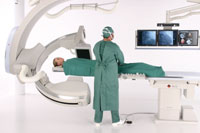 The Infinix-i series with flat panel detector technology offers a
wide range of configurations. Configurations include: single plane floor and
ceiling mounted cardiovascular systems, cardiac and vascular biplane systems,
and a no compromise dual plane universal system. Each system offers
unprecedented patient access and coverage and is feature-rich for better
patient care and higher productivity. For example, the systems offer quiet,
instant on liquid metal-bearing X-ray tube, Advanced Image Processing (AIP) for
enhanced vessel and device visualization, and superb patient access.
The Infinix-i series with flat panel detector technology offers a
wide range of configurations. Configurations include: single plane floor and
ceiling mounted cardiovascular systems, cardiac and vascular biplane systems,
and a no compromise dual plane universal system. Each system offers
unprecedented patient access and coverage and is feature-rich for better
patient care and higher productivity. For example, the systems offer quiet,
instant on liquid metal-bearing X-ray tube, Advanced Image Processing (AIP) for
enhanced vessel and device visualization, and superb patient access.
Toshiba Aquilion® Premium

GE Healthcare LightSpeed CT750 HD
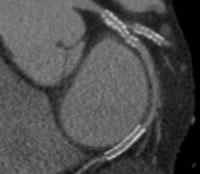 GE Healthcare’s LightSpeed CT750 HD is the world’s
first high definition CT scanner. LightSpeed CT750 HD boasts the world’s
fastest CT detector and the first new detector material in 20 years. The
material, comprised of molecularly altered garnet gemstones, collects imaging
data 100 times faster, with up to 33% greater detail through the body and up to
47% greater detail in the heart than today’s industry standard. The image
here shows the device’s visualization of a 2 mm distal stent. LightSpeed
CT750 HD improves image quality while reducing dose by up to 50% across the
entire body and by as much as 83% for cardiac scans.
GE Healthcare’s LightSpeed CT750 HD is the world’s
first high definition CT scanner. LightSpeed CT750 HD boasts the world’s
fastest CT detector and the first new detector material in 20 years. The
material, comprised of molecularly altered garnet gemstones, collects imaging
data 100 times faster, with up to 33% greater detail through the body and up to
47% greater detail in the heart than today’s industry standard. The image
here shows the device’s visualization of a 2 mm distal stent. LightSpeed
CT750 HD improves image quality while reducing dose by up to 50% across the
entire body and by as much as 83% for cardiac scans.
Siemens ACUSON SC2000™

Siemens SOMATOM® Definition Flash

Siemens Artis zeego®

Philips CX50 CompactXtreme
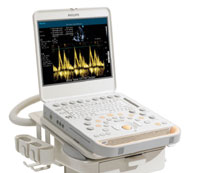 CX50 CompactXtreme, Philips’ new handheld ultrasound system,
helps improve diagnostic confidence by providing high-quality images at the
bedside, even for the most technically difficult patients. Designed to meet the
needs of cardiologists, the system offers the convenience of portability while
providing the premium image quality of a traditional, full-size system. It can
enhance diagnostic details, allow for shorter exam times and reduce the need
for repeat studies, that are often required with portable systems that provide
inconclusive data due to poor image quality.
CX50 CompactXtreme, Philips’ new handheld ultrasound system,
helps improve diagnostic confidence by providing high-quality images at the
bedside, even for the most technically difficult patients. Designed to meet the
needs of cardiologists, the system offers the convenience of portability while
providing the premium image quality of a traditional, full-size system. It can
enhance diagnostic details, allow for shorter exam times and reduce the need
for repeat studies, that are often required with portable systems that provide
inconclusive data due to poor image quality.
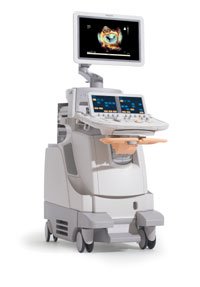 Philips iE33 Echocardiography System
Philips iE33 Echocardiography System
The iE33 Echocardiography System features extraordinary levels of 2D image quality, powerful 2D and 3D measurement of cardiac function and anatomy, live 3D imaging of the beating heart, and user-centered ergonomics. The Vision 2008 upgrade for the iE33 offers new tools for acquiring more information with greater accuracy, including the C5-1 transducer and Mitral Valve Quantification, a new QLAB plug-in, to allow precise 2D and 3D quantification of mitral valve anatomy and associated structures based on data acquired with the Philips Live 3D TEE, X7-2t transducer.
Philips MX Series
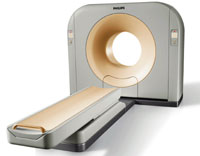 The Philips MX series is a family of CT scanners that have a
loyal customer following in many parts of the world. The 16-slice MX system has
one of the widest high-quality imaging detectors in its class, providing fast
high-resolution scanning, shorter breath-hold times and improved patient
comfort.
The Philips MX series is a family of CT scanners that have a
loyal customer following in many parts of the world. The 16-slice MX system has
one of the widest high-quality imaging detectors in its class, providing fast
high-resolution scanning, shorter breath-hold times and improved patient
comfort.
The MX is a high-performing scanner, capable of executing all routine applications, including exams like CT angiography (CTA), where a 16-slice scanner is typically required. The system is ideal for those customers who want to replace their current scanner or add a second system, but have purchasing cost concerns stemming from economic pressures.
Boston Scientific iCross™ Coronary Imaging Catheter

The iCross Catheter’s unique coating absorbs water molecules to create a rapidly-formed interface at the surface of the device. This coating makes the catheter very slick and thus reduces the catheter push force. The 40 MHz catheter also provides outstanding image clarity and image resolution. The large imaging window clearance is intended to decrease friction in tortuous anatomy.
